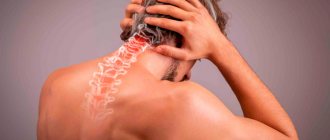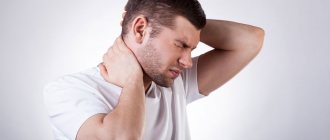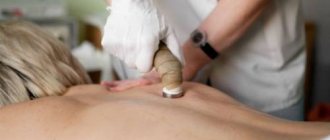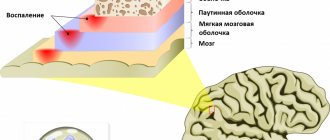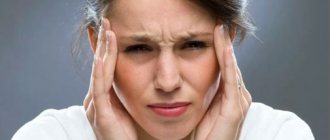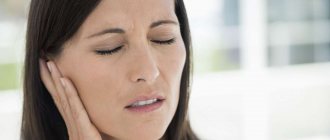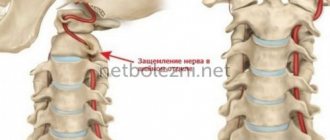Causes of pain in the back of the head on the left side of the head
Pain and discomfort are not a separate disease, so there are many reasons why the left back of the head hurts. The simplest ones are fatigue, lack of sleep, strong emotions, high air pollution. They pass immediately after rest and creation of comfortable conditions. Also, this symptom may indicate a number of diseases of the cervical spine, blood vessels and nerves, which require timely diagnosis and treatment.
Diseases of the cervical spine
If the occipital part of the head on the left hurts, it is important to conduct an examination of the cervical spine. It is here that the important vertebral artery passes, which carries blood to the head and nourishes nerve tissue. Pathological formations in the vertebral area, bone calluses, muscle spasms lead to compression and a decrease in blood flow to the brain.
- Osteochondrosis is a chronic disease of the intervertebral discs and joints associated with a slowdown in metabolism and blood circulation. It often occurs in older people, but can also result from injuries and diseases of the spine at any age. The cartilage becomes thin and inelastic, and the process of deformation of the vertebrae and the formation of bone calluses begins.
- Protrusion – protrusion of intervertebral discs in any direction. The pathological process goes through several stages, the last of which is a hernia. It occurs with rupture of the dense fibrous membrane and release of the cartilage contents. In advanced cases, treatment requires surgery.
- Displacement of the vertebrae - often due to injuries and falls, but can also be a consequence of weak ligaments. The process is accompanied by acute pain in the neck, compression of blood vessels and nerve roots. The pain in the occipital part of the head on the left is sharp, throbbing, intensifies during movements and turns of the head. It goes away if the normal position of the vertebrae is restored, but it is important to prevent them from being displaced again.
Treatment tactics for various diseases of the cervical spine will differ. It is important to eliminate the cause of compression of blood vessels and nerves, restore normal blood supply and innervation of tissues. For most patients, massage, gymnastics, and taking muscle relaxants and antispasmodics are sufficient, but in some cases surgical intervention may be necessary.
Muscle diseases in the neck area
Muscle spasms and inflammation of soft tissues are one of the reasons why the left back of the head hurts. Discomfort spreads to the neck and occipital region, and can affect the entire surface of the head. During diagnosis, a number of muscle pathologies in the cervical region can be determined, which cause an acute headache in the left occipital region.
- Myositis is inflammation of the muscles. The process can be of traumatic or infectious origin, or result from hypothermia of the neck and head. The pain is acute and persists even at rest, and the skin over the affected area becomes inflamed and acquires a red tint. For most patients, anti-inflammatory and analgesic ointments are sufficient for treatment.
- Muscle strain is a micro-tear of fibers. This damage occurs as a result of sudden movements of the neck, falls, or prolonged exposure to an uncomfortable position. The most dangerous is a complete rupture of the muscle - it must be restored surgically.
- Myogelosis is a disease in which painful lumps form in the muscles. They limit the mobility of the cervical spine, compress blood vessels and nerves, and lead to the formation of ischemic areas in the brain. For treatment, muscle relaxants, massage and physiotherapy sessions are prescribed.
One of the reasons why the left occipital part of the head hurts is a sedentary lifestyle, working at a monitor. Lack of movement causes muscle spasms, slow blood circulation, and ischemia of brain tissue. Doctors at the Clinical Brain Institute recommend periodically warming up during the working day to maintain vascular health.
Nerve diseases
If the back of the head on the left side of the head hurts severely, this may be a manifestation of neuralgia. The pain is acute, throbbing, and persists both during movement and at rest. Its source is the greater occipital nerve, which originates from the second cervical root and passes under the base of the skull. Painful sensations can be caused by the following pathologies:
- neuritis - inflammation of the nerve;
- mechanical compression, pinching of nerve fibers;
- incorrect posture;
- diseases of the cervical spine associated with anomalies in the location of the vertebrae;
- abnormal physical activity.
Neuralgia can occur in acute or chronic forms. It is often shooting and has a high intensity. When the greater occipital nerve is damaged, it spreads to the neck and back of the head. Treatment depends on the cause of the pain. In case of mechanical compression of the nerve, it is important to restore its conductivity; in case of infectious diseases, a course of antibacterial therapy is prescribed. At home, you can additionally use ointments with the addition of painkillers and anti-inflammatory components.
Vascular diseases
Pain in the back of the head on the left side of the head is a reason to undergo a vascular examination. Spasms, inflammatory and dystrophic processes lead to deterioration of blood circulation. Areas appear in the brain that are deficient in oxygen and nutrients. There are a number of diseases that manifest themselves as pain in the left or right back of the head, associated with pathologies of the vascular system.
- Hypertension is a chronic increase in blood pressure. It often manifests itself in older people, and can also be associated with abnormalities in the structure of blood vessels, physical activity, and metabolic disorders. The walls of the arteries gradually stretch under blood pressure, becoming thin and inelastic. Hypertension is one of the main risk factors for the development of hemorrhagic stroke.
- Hypotension is a decrease in blood pressure. Its causes include heart disease, insufficient vascular tone, anemia and other factors. If the condition occurs frequently, you must follow a special diet and take medications to increase your blood pressure. Long-term oxygen deficiency negatively affects brain function, leads to headaches, and can provoke an attack of ischemic stroke.
- Atherosclerosis is a disease of large arteries associated with impaired lipid metabolism. Excess cholesterol and some fractions of lipoproteins accumulate on the inner wall of blood vessels, forming deposits and plaques. Detecting this disease at an early stage will prevent its further development. In the later stages, atherosclerosis is dangerous due to the complete blocking of the lumen of the vessel, as well as rupture of its walls.
Fluctuations in blood pressure and vascular disease are one of the risk factors for stroke. This is a dangerous condition that represents an acute cerebrovascular accident. An attack occurs either when an artery ruptures, or due to a prolonged lack of oxygen in certain areas. The treatment and rehabilitation regimen depends on the type of stroke and the size of the affected area, as well as the age of the patient and the presence of concomitant diseases.
Other reasons
If the left side of the back of the head hurts, it is worth undergoing a detailed diagnosis and determining the exact cause of this symptom. During the examination, it is important to indicate all the conditions for the appearance of painful sensations, as well as additional complaints. Discomfort can be associated with a variety of diseases and conditions, including:
- migraine;
- prolonged fatigue, stress and insomnia;
- poor nutrition, excessive consumption of fatty and salty foods;
- sedentary lifestyle.
In most cases, pain in the back of the head on the left goes away after proper rest. Doctors at the Clinical Institute of the Brain recommend that you seek examination if painful sensations occur frequently or are acute.
Causes of pain in the back of the head
The occurrence of cephalgia, which is concentrated in the back of the head, most often turns out to be the result of diseases of the cervical spine. Slightly less often, the symptom occurs against the background of decreased functionality of blood vessels.
When establishing the causes of the appearance of a symptom, one cannot exclude the possibility of the presence of a neurological disease, the formation and growth of a tumor, or the consequences of a traumatic brain injury. Another headache in the back of the head may indicate an “occupational” illness of people engaged in intellectual work or be the result of ordinary stress.
Neuralgia of the left occipital nerve
Damage to the nerve fibers of the cervical plexus is accompanied by severe headaches. It is localized in the occipital part, and the sensations are so pronounced that the patient
it feels like the back of his head is on fire. The symptom may also be accompanied by lumbago and pulsation. It radiates into the eyes, lower jaw and area behind the ear. The sensitivity of the skin in the affected area is often impaired. The patient's fingers and hands become numb. The skin becomes pale and painful. The back of the head on the left side hurts so much that the patient is afraid to move. Turning the head, coughing, laughing and sneezing increase the intensity of the sensations.
The cause of the disease can be spinal trauma, connective tissue pathologies, infectious diseases and neoplasms. The diagnosis is made based on the clinical picture. Treatment involves eliminating the irritating factor and carrying out symptomatic therapy. As the pain decreases, drug therapy is supplemented with massage and physical therapy.
Osteochondrosis of the cervical spine
The left side of the back of the head may hurt due to a failure of the blood circulation process in the tissues of the area against the background of vasospasm. This occurs as a result of changes in the structure of the cartilage of the intervertebral discs and a decrease in the functionality of the channel through which nerves and blood vessels pass.
Today, the disease is increasingly common in young people leading a sedentary lifestyle. Risk factors also include obesity, curvature and injuries of the spine, disruptions in metabolic processes, and excessive physical and emotional stress.
Clinical picture of osteochondrosis:
- occipital localization of cephalgia - dull or shooting sensations can radiate to the arms or shoulders;
- decreased sensitivity and muscle weakness of the upper extremities;
- stiffness in the neck and crunching when turning the head;
- blood pressure surges due to vascular compression, there is a high probability of developing hypertension;
- loss of coordination due to dizziness, general and muscle weakness;
- hearing impairment, double vision, numbness of the tip of the tongue - with prolonged poor circulation in the occipital part of the skull;
- in difficult cases, a cervical migraine develops - an attack of sharp pain running from the back of the head to the temple or brow ridge, accompanied by darkening in the eyes and a buzzing in the ears.
The fight against pathology is based on drug therapy. The patient is prescribed
NSAIDs, muscle relaxants, chondroprotectors, vitamins. Treatment is complemented by massage, physiotherapy and exercise therapy. A person’s lifestyle must be reviewed, and physical exercises are introduced into his regimen.
Tension headaches
In this case, cephalalgia often originates in the left side of the back of the head due to the large accumulation of nerve endings in the area. It occurs due to a failure of metabolic processes in the area as a result of spasm of muscle fibers. This type of pain is a consequence of stress, physical or mental overload, which leads to prolonged muscle tension. People who lead a sedentary lifestyle and refuse physical exercise are predisposed to it. The sensations are oppressive. Gradually they spread along the perimeter of the skull and cover the entire head like a hoop or a tight headdress.
Pain in the back of the head on the left with this disease is not organic, and therefore is rarely accompanied by specific alarming symptoms. The patient experiences a deterioration in mood, he becomes irritable and inattentive. It is difficult for such a person to concentrate on work. Managing tension-related pain rarely requires medication.
Get enough rest, adjust your work and rest schedule, and introduce physical activity into your routine. Additionally, it is recommended to warm up the problem area from time to time using massage or therapeutic exercises. You can drink sedatives based on natural ingredients.
Migraine
The neurological disease is characterized by systematic pain in the occipital part of the head. The symptom affects one hemisphere; its symmetrical manifestation is rare. Sensations originate in the frontal area or the back of the head, spread to the temple and cover the entire half of the skull. The type of pain is throbbing, persistent, intrusive. Attacks occur from 1-2 times a year to once every few days. The more often they develop, the lower the intensity of cephalalgia.
The risks of developing a disease that is attributed to a hereditary nature increase under the influence of the following factors:
- stress, nervous and physical strain;
- refusal of healthy food in favor of semi-finished products, fast food, products with chemical additives;
- smoking, alcohol abuse;
- taking pharmaceutical and folk medicines or oral contraceptives without consultation with a doctor;
- lack or excess sleep;
- sudden change in weather or climate.
With migraine, pain occurs suddenly or after the appearance of warning signs in the form of an aura. They are accompanied by increased sensitivity of the patient to light, sounds and smells. Dizziness, muscle weakness, and restlessness may be present.
Often, a person with a migraine exacerbation is unable to do normal activities until the attack passes or subsides. At the peak of pain, nausea appears. If it leads to vomiting, the patient feels relieved and may fall asleep.
Migraine treatment is aimed at relieving pain, eliminating other symptoms, and preventing exacerbations. For these purposes, medications, traditional medicine, physiotherapy and reflexology methods can be used. As the patient gets older, the disease often weakens, and at some point the attacks stop.
Injuries
The causes of pain in the back of the head after head and neck injuries are: violation of the integrity of the skin, increased blood pressure, intracranial hemorrhage. The symptom appears immediately after the blow or after some time. At the same time, cephalalgia is characterized by a permanent nature. The localization of sensations most often corresponds to the site of injury. They may be accompanied by dizziness, nausea, confusion, poor coordination, fainting, or short-term memory loss.
Delayed pain in the back of the head on the left side often appears after a temporary improvement in the patient’s condition. In this case, it is necessary to undergo diagnostics and make sure that there is no bleeding or extensive hematomas. The treatment method depends on the patient's condition and the type of injury. In mild cases, first aid boils down to bed rest, a cool compress on the problem area and taking painkillers.
Arterial pressure
Blood pressure readings outside the physiological norm are accompanied by cephalgia.
Due to the structural features of the vascular network, it originates and is concentrated in the occipital part of the head. The sensations arise as a result of changes in the fullness of the blood channels and the diameter of their lumen, and increased blood pressure on their walls. Contrary to popular belief, unpleasant symptoms are typical not only for hypertensive patients, but also for people with low blood pressure.
Types and characteristics of headaches in the back of the head with hypertension:
- against the background of muscle tension - increases gradually, complemented by nausea and dizziness. The patient experiences compression at the base of the skull on one side or both. Most often it appears due to stress that causes a spasm of the blood channels;
- as a result of impaired blood outflow due to vasoconstriction - pain on the left side of the head is complemented by heaviness in the head. The sensations are pulsating and radiate to the temple. They intensify when coughing, sneezing, or moving the head;
- due to spasm of the arteries - aching or dull cephalgia, which is accompanied by dizziness, disorientation, and nausea. The patient feels as if a hoop is pressing on his head;
- cerebrospinal fluid pain due to changes in blood pressure - pulsating cephalgia, which can intensify with physical activity;
- neuralgic pain – characterized by suddenness and extreme intensity. They radiate to different parts of the skull, neck, and upper back. They are the result of stress, increased intracranial pressure, and compression of the trigeminal nerve.
Obsessive throbbing occipital pain is characteristic of hypotension. Due to decreased vascular tone, blood rushes into the skull. In this case, pain occurs in the back of the head, radiating to the parietal and temporal regions. It is especially pronounced in the morning, after waking up, and gradually disappears during the day due to the person’s physical activity. The sensations intensify in a horizontal position of the body, when bending forward and tensing the muscles of the neck or upper back.
Vascular diseases
Pathological processes in the vessels of the neck and back of the head, which provoke circulatory disorders, are always accompanied by a headache. Often it is localized on the left side of the skull. Violation of the tone of the walls of blood channels leads to an increase in their mobility. The tissues irritate the nerve receptors, causing cephalgia. Alarming signs begin to appear already in the initial stages of vascular diseases. They are aggravated by external factors such as lack of sleep, excessive physical activity, weather changes, staying in a stuffy room, smoking and drinking alcohol.
If the left side of the back of the head hurts severely and this is associated with vascular problems, you should not take painkillers uncontrollably. To relieve symptoms, sometimes it is enough to normalize the emotional background; in case of hypertension, blood pressure should be lowered. Hot foot baths, room ventilation, and taking an antihypertensive drug as recommended by a doctor will help with this. If possible, you should take a sedative or sleeping pill to get some sleep.
Oncological pathology
Systematic or constant pain in the head is an indication for a thorough diagnosis of the brain, regardless of its location.
First of all, doctors must make sure that the person does not have tumors in the skull. Malignant tumors pose the greatest danger. Even with a small size, they release harmful substances that can reduce the functionality of the organ. They are also prone to rapid growth and the formation of metastases. Such formations cause a whole list of alarming symptoms: nausea and vomiting, dizziness, changes in perception of the surrounding world, hallucinations, confusion.
Benign tumors are dangerous because as they grow, they begin to compress blood vessels, which leads to oxygen starvation of entire areas and increased intracranial pressure. The condition is characterized by the appearance of throbbing pain, a feeling of fullness and anxiety. Nausea and vomiting may also occur. As cerebral ischemia develops, symptoms appear indicating a decrease in the functionality of the organ.
Examination methods
If the occipital part of the head on the left often hurts, it is important to undergo a full diagnosis. During the initial examination, the therapist prescribes additional examinations from specialized specialists, as well as the necessary tests:
- blood tests to determine its composition, identify viral and bacterial infections and obtain other indicators;
- X-ray or MRI of the cervical spine if disease in this area is suspected;
- examination of the vessels of the neck and head using Dopplerography - ultrasound diagnostics using a contrast agent;
- MRI, CT scan of the brain is an accurate, informative technique for detecting neoplasms, hemorrhages and other pathologies that can cause headaches;
- specific examinations by a neurologist, traumatologist, ophthalmologist and other specialized specialists according to indications.
The Clinical Institute of the Brain has all the necessary conditions for diagnosing diseases that are accompanied by headaches. Accurate test results, high-quality modern equipment, many years of experience of specialists are the main advantages of the center.
Headache treatment
The treatment regimen is selected for each patient individually. It is prescribed taking into account the exact diagnosis, the general condition of the patient and the presence of concomitant diseases, as well as other factors. The main condition for successful treatment is strict adherence to all recommendations at home and carrying out all necessary procedures:
- taking medications – the doctor may prescribe medications to improve blood circulation, painkillers, antibiotics and drugs to correct blood pressure;
- proper nutrition - the diet should contain enough vitamins and microelements, and the consumption of fatty foods, salt and spices, and semi-finished products should be limited;
- physiotherapy – a set of techniques to improve nutrition and blood supply to tissues in diseases of the cervical spine;
- massage, therapeutic exercises - are prescribed additionally for spinal curvatures, osteochondrosis and other disorders.
If you have a headache in the back of the head on the left, it is important not to self-medicate. Rest, fresh air, head massage are the simplest techniques that will help get rid of discomfort in the absence of serious illnesses. In other cases, it is important to follow doctors’ orders and undergo periodic examinations.
Prevention methods
To prevent diseases of blood vessels and nerves, pathology of the cervical spine, as well as to prevent stroke, you should follow simple recommendations from doctors every day:
- when working sedentarily, regularly do simple exercises for the back and neck;
- lead an active lifestyle, carry out daily exercise necessary for health;
- create a complete diet with a sufficient amount of vitamins and minerals;
- give up bad habits: smoking and drinking alcohol.
Headache in the left occipital part of the head is a manifestation of a number of diseases of the cardiovascular system, nerves and spine. The Clinical Brain Institute has all the conditions for diagnosing and treating this condition in an inpatient or outpatient setting. The center is equipped with modern devices for analyzes and examinations, and is also staffed by experienced specialists of a narrow and broad profile.
Clinical Brain Institute Rating: 4/5 — 15 votes
Share article on social networks
Why does the back of the head on the left side hurt?
Headaches appear suddenly, the causes of their occurrence are very diverse. Left-sided headaches in the back of the head often occur with pathological changes in blood vessels on the left side. Spasm of blood vessels on the left side often occurs when a nerve is pinched in the cervical spine. The pain is localized on the side where blood circulation is impaired.
Intracranial pressure
Left-sided headache is a common sign of increased intracranial pressure, which occurs due to stagnation of cerebrospinal fluid (CSF) and increased intracranial pressure . Impaired circulation causes an accumulation of cerebrospinal fluid in a certain part of the brain; if this accumulation occurs in the occipital region on the left side, pain appears on the left.
Hypertension
An increase in blood pressure is accompanied by a sharp narrowing of the lumen of blood vessels. This leads to spasms in various parts of the brain. The most common location is the left side of the back of the head. With hypertension, the pain is constant, pressing, throbbing .
Injuries
Traumatic head injury is often accompanied by damage to blood vessels with further formation of hematomas and tissue swelling at the site of injury. Innervation is disrupted, nerve endings are compressed , resulting in pain. Signs appear in the area of damage, for example, if the blow is from the left, pain develops on the corresponding side of the skull.
Osteochondrosis
Under the influence of pathological processes, irreversible changes occur in the tissues of the spine. This leads to disruption of the normal shape and size of the vertebrae, as a result of which blood vessels and nerves are compressed, and the nutrition of brain cells deteriorates . Most often, changes develop on one side, which provokes the appearance of left-sided pain in the back of the head.
Migraine
With migraine, the sensations are often not local, but diffuse in nature, quickly spreading from the back of the head to the temple, eye, jaw and forehead on one side , often it is localized on the left. Patients complain of nausea, vomiting, sweating, weakness and chills. The duration of a migraine attack varies, from 1-3 minutes to 3-5 days.
Vascular problems
People suffering from increased meteosensitivity often complain of pain in the back of the head on the left . Unpleasant sensations appear when the weather changes, after physical or mental stress. Accompanied by an increase or decrease in blood pressure. Pain is felt in the area where vasospasm occurs.
Occipital neuralgia
Develops as a result of inflammation of the occipital nerve with osteochondrosis, spondyloarthrosis, after exposure to a draft or hypothermia. The pain is not concentrated in the back of the head, but spreads to the neck, ears, temples, and jaw. The disease has an acute, pulsating, paroxysmal course. Often localized on the left side.
Occupational pain
They develop in people whose work involves prolonged exposure to a forced position . As a result, the neck muscles are subject to severe stress, which leads to headaches. This problem develops among drivers, jewelers, seamstresses and representatives of other similar professions.
The pain goes away after changing body position, a short warm-up or a light massage.
Other reasons
Other causes of headaches include physical and mental stress, myositis, pathologies of the left temporomandibular joint, myogelosis, incorrect posture, diseases of the central nervous and cardiovascular systems, infectious diseases of the brain, in which the vessels on the left side are affected.
